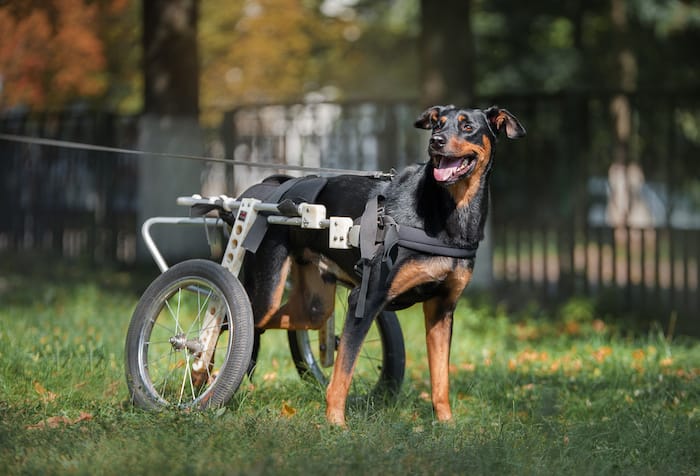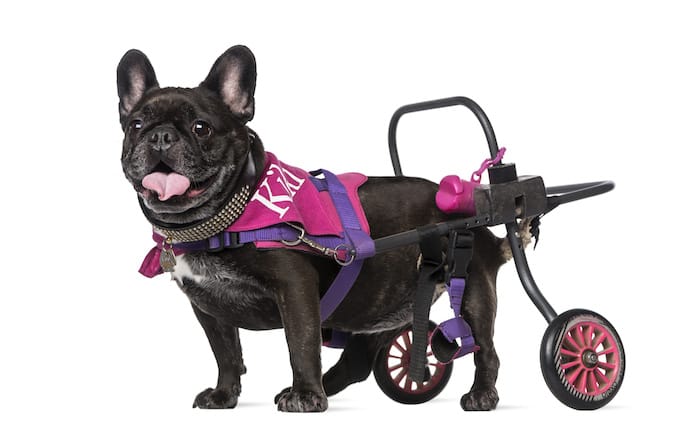Disabled dogs don’t know they’re different and can easily adjust to their situations. Yet, they deserve additional care and attention from their fur parents. Walking disabilities for dogs may result from growth abnormality, genetic disorders, disease, accidents, or age.
Nowadays, the chance of a dog to live a happy and ordinary life despite their condition is nowhere near slim. Thanks to the invention of dog wheelchairs, dogs can now freely run and play around like how they should be. Dog wheelchairs generally come in different models and sizes to fit large and small pets.
What Is A Dog Wheelchair And How Does It Work?
A dog wheelchair aims to meet the exact requirements of a human wheelchair. Enabling its mobility-impaired passenger to move freely, efficiently, and painlessly is its primary goal. The most significant distinction is, of course, in anatomy.
A human wheelchair is a chair that has wheels attached to it. Manufacturers devised the design of dog wheelchairs to provide mobility support since dogs use at least two feet for propulsion. They increase comfort and movement by removing extra weight off ill or shaky legs.
Common Causes Of A Dog’s Walking Disability
While the difficulties of “old age” may frequently be the reason for dogs’ walking problems, other disorders can also cause similar issues.
Some of the conditions that may affect a dog’s ability to walk are the following:
- Arthritis
It’s a frequent issue in dogs, causing pain, stiffness, and discomfort. Cartilage inside their joint (hip, elbow, etc.) changes or is damaged in dogs with arthritis, making it less smooth and causing the bones in the joint to rub together. This rubbing may be unpleasant or painful, further damaging the cartilage. New bone grows around the joint directly due to the increased friction, making it stiffer and more challenging to move (known as a degenerative joint disease).
- Hip Dysplasia
It’s a condition in which the ball and socket joint of the hips fails to develop correctly, resulting in lameness and severe arthritis. Hip dysplasia is the most common cause of lameness in dogs’ back legs, particularly in large breeds like Newfoundland, Saint Bernard, Chesapeake Bay Retriever, and German Shepherd. Studies show that 20 to 40% of large-breed dogs suffer from the disease.
- Intervertebral Disc Disease (IVDD)
IVDD is a progressive, age-related degenerative condition that damages the dog’s spinal cord over time. The shock-absorbing discs between your dog’s vertebrae eventually harden until they can no longer cushion the vertebrae properly, resulting in IVDD.
- Degenerative Myelopathy (DM)
DM is a spinal cord illness that causes weakening and paralysis in the hind limbs. Degeneration of the white matter of the spinal cord causes the symptoms. Many human amyotrophic lateral sclerosis (ALS), often known as Lou Gehrig’s Disease, is comparable to DM.
- Spinal Muscular Atrophy (SMA)
SMA is a hereditary condition characterized by muscle wastage (atrophy) and weakness (skeletal muscles). SMA occurs when there is a loss of motor neurons, specialized nerve cells that govern muscular movement.
- Other Sicknesses
Difficulty or the loss of the ability to walk may also result from paralysis, spinal problems, amputation, knee injuries, or surgical recovery.
Signs That A Dog Needs A Wheelchair
Your veterinarian will be an enormous help in deciding whether or not your disabled dog will benefit from the use of a wheelchair. A veterinarian may advise against using such a device in certain instances, such as when the dog needs to grow muscle for a brief injury.
A wheelchair, on the other hand, is the ideal option for a dog that is old or has persistent injuries. It’s also recommended for paralyzed dogs. And if you see any of these symptoms, contact your veterinarian right away to discuss a mobility device plan.
Below are signs that your dog needs a wheelchair:
- Changes in behavior or irritation that occur suddenly, particularly while moving or placing weight on the legs and joints
- Standing up is difficult
- Having difficulties in maintaining balance
- Reluctance to leave the house
- Fear or apprehension when confronted with stairwells, uneven terrain, or slick surfaces
- Muscle atrophy or weakness
- Paralysis
Benefits Of Dog Wheelchairs
- Wheelchairs Restore Mobility
Your disabled dog will eventually lose their natural movement. The condition compromised morning walks, physical play, and the ordinary everyday activities of dogs. Fortunately, with the proper fit and diagnosis, a wheelchair may help your dog regain mobility.
- Avoids Emotional Strain
Unfortunately, your dog cannot express emotions, unlike people. However, it’s reasonable to infer that your dog’s injuries and present immobility have an emotional impact. The disability gravely affected pets’ mental and physical well-being by making them unable to play and move about as they formerly did.
- Provide Comfort And Rehabilitation Support
The mechanism will support Dysplasia, hind end weakness in dogs, or weakened bones and limbs, allowing for comfortable movement. Some patients also use wheelchairs as therapy for a dog’s recovery from some conditions.
- Gives More Confidence
Even a partial restoration offers a substantial boost in your dog’s confidence and happiness. It is critical to recognize and appreciate success, whether minor or significant, while progressively using the dog wheels. The praises from their owners give comfort to the dog and a boost in their self-assurance.
- Living A Typical Life Is Possible
By combining the advantages above, your dog will be one step closer to living a natural life. The doggie wheelchair provides mobility, comfort, confidence, and happiness, the hallmark of every dog’s lively and fun personality.
Choosing The Suitable Wheelchair For Your Dog
When choosing a wheelchair for your dog, one of the first considerations is whether he needs a rear support wheelchair or an entire support wheelchair. The degree of your dog’s condition and which limbs are afflicted will influence your decision.
Similarities And Differences In Wheelchair Designs
- Rear Support Dog Wheelchair
Dog wheelchairs with back support are great for dogs with back legs but have muscular strength and movement in their front legs. A set of wheels are put on a chassis and strapped around the dog’s back legs. A pair of rails extend forward to the dog’s abdomen, where an extra strap secures them.
- Full Support Dog Wheelchair
If your dog is experiencing difficulties with his front legs or all four limbs, you might consider getting him a full-support dog wheelchair. It looks like a rear leg support wheelchair in the back, but the side rails run to the front legs, connecting to a second pair of supporting front wheels. A soft harness cushion supports the dog’s tummy.
How Dog Wheelchairs Improve Your Dog’s Quality Of Life
The objective of wheelchairs for your disabled dog is to induce comfort, just as it is for people. The goal of comfort for your dog always leads to a slew of advantages, and our pets may attain such comfort with dog wheels.
In a Nutshell
Your dog’s life doesn’t just because they have lost or have limited use of their legs. A variety of therapy equipment built expressly for mobility-challenged or handicapped dogs is available in today’s animal rehabilitation operations. One of the most typical solutions to mobility-related issues is a dog wheelchair. Purchasing a wheelchair for your impaired dog, as easy as it may seem, may significantly enhance their quality of life. Every dog deserves to be happy and to be able to run about freely.




